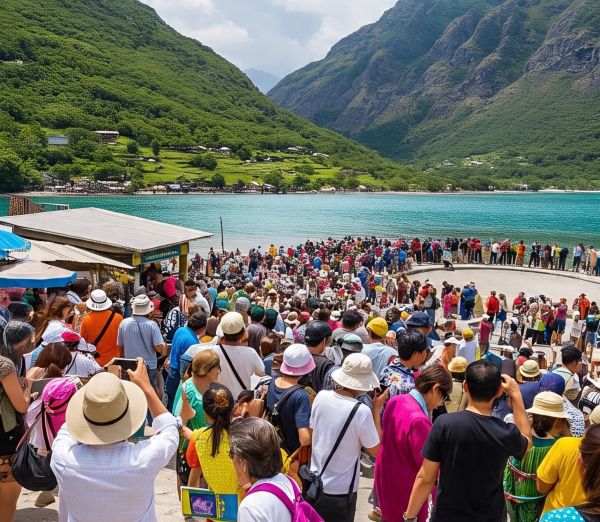Tuesday, June 3, 2025
A Global Reckoning on Mass Tourism
Across several parts of the world, officials have begun reassessing the impact of mass tourism on local environments and communities. One of the clearest signs of this shift was seen in Thailand, where officials announced the temporary closure of Similan and Surin Islands through the summer months. This decision was made to allow these fragile ecosystems a chance to recover from the heavy toll taken by tourists. There were also discussions around introducing entry fees to better regulate the flow of visitors.
In Tenerife, a new restriction was introduced limiting daily visits to the Pico del Teide volcano to 300 tourists. The goal was to preserve a cherished natural landmark and prevent it from becoming overrun. Venice, meanwhile, began charging up to €10 for day-trippers, and Lisbon followed suit with a €2 tax on every cruise passenger coming ashore.
Other European cities, including Paris, took steps to manage tourism digitally. Restrictions were placed on how many days residents could list their homes on short-term rental platforms, aiming to balance tourism income with housing availability.
Decentralizing the Tourist Crowd
Faced with rising frustrations from locals and visible strain on infrastructure, many major tourist cities adopted new tactics to redistribute visitor traffic. Authorities in cities overwhelmed by footfall began promoting lesser-known attractions outside the traditional tourist hubs. This approach was meant to ease pressure on iconic landmarks and improve the overall visitor experience.
In a standout example, Copenhagen opted to encourage sustainability by offering incentives for train travelers. Those who arrived by rail were given free bicycle rentals, access to guided walking tours, discounted tickets, and even yoga classes—a model now being closely watched by other cities grappling with similar issues.
Media Exposure Fuels Location Overload
One of the newer contributors to overtourism has been the influence of pop culture. Fans have been known to flood locations featured in films and TV series—a phenomenon dubbed “set-jetting.” This was particularly evident in Dubrovnik, thanks to its connection to Game of Thrones, and in Hallstatt, Austria, which gained attention from the Korean drama Spring Waltz. While these locations enjoyed global fame, the influx of fans often overwhelmed their infrastructure.
Adding further pressure were cruise ships, whose large passenger volumes often descend on ports for just a few hours. Despite their brief stays, these visitors typically place a heavy burden on local services without significantly boosting the local economy, as most spending happens aboard the ships.
Flights and Short Getaways Escalate the Problem
According to the Swiss nonprofit fairunterwegs, the rise of budget airlines and nearby airports has made it too easy for people to travel frequently, especially for short holidays. This accessibility has been a major factor in the tourism explosion in Mallorca, which owes much of its popularity to affordable flights.
In Germany alone, travelers made 94 million short trips last year—a 25% increase. While these breaks are often brief, the frequent flights associated with them contribute disproportionately to carbon emissions, making them a significant environmental issue.
A Growing Carbon Footprint
Tourism now accounts for an estimated 8–10% of global greenhouse gas emissions, a number that surged by 65% between 1995 and 2019. Notably, air travel, although used for just a quarter of vacation trips, was found to be responsible for three-quarters of tourism-related emissions. Additional emissions came from local transport, accommodations, and on-site activities.
Frequent short trips were flagged as one of the most damaging trends, as they intensify environmental degradation in both urban and natural areas. In warm climates and island settings, visitors—especially wealthier tourists—tended to consume significantly more water than locals, further stretching fragile resources.
Environmental Wear and Tear in Urban Settings
The impact of overtourism went beyond just carbon emissions. Cities and destinations worldwide have been grappling with noise pollution, litter, traffic congestion, and the irresponsible use of drones. These factors not only disrupted the lives of residents but also affected local wildlife and ecosystems.
On Majorca, wastewater discharged into the sea had been shrinking the underwater seagrass meadows, which are essential for climate resilience. Similarly, in Rome and Gran Canaria, the landscape was being altered to accommodate tourists, with the creation of extra walkways and new parking lots that interfered with nature.
The Canary Islands: At Breaking Point
Nowhere has the tension between tourism and sustainability been more apparent than in the Canary Islands. With just 2.2 million residents, the islands reportedly welcomed 15.2 million tourists in 2023—and that number was expected to grow even further this year.
Although tourism made up over a third of the local economy, it was suggested that major investors profited the most. Meanwhile, housing became scarcer, rents climbed, and natural landscapes deteriorated. Many property owners were said to be shifting toward short-term vacation rentals, further limiting housing options for locals.
Tourism’s Unstoppable Growth—and Its Price
Globally, the tourism sector appeared to be returning to pre-pandemic levels, with 1.5 billion travelers recorded last year—the second-highest number on record after 2019. Popular destinations such as Rome, Mallorca, and the Canary Islands found themselves swamped by visitors.
While tourism undeniably supports many economies, the recent boom had also brought rising social tensions, infrastructure strain, and environmental degradation. The UN World Tourism Organization had warned that overtourism occurs when the quality of life for residents and experience for travelers both decline significantly.
- Tourism emissions now represent up to 10% of the global total.
- The Canary Islands hosted 15.2 million visitors in 2023—nearly seven times their resident population.
- Air travel, short-term trips, and cruise ship tourism are the leading causes of overtourism.
- Governments are responding with visitor caps, taxation, and digital crowd controls.
If these trends continue unchecked, the very destinations people travel to enjoy could suffer irreparable harm—both ecologically and socially.
